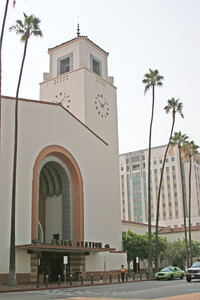A pedestrian’s guide to exploring Los Angeles
East Coast natives, especially those hailing from the Tri-State area, come to Los Angeles with a heavy bias, one made heavier by Woody Allen’s infamous grudge with the City of Angels — it was Allen, after all, who quipped, “I don’t want to move to a city where the only cultural advantage is being able to make a right turn on a red light.”
It’s hard to blame Allen: With its concrete overpasses, dwarfed architecture and distant neighborhoods that are seemingly impossible to get to by anything but one’s own car, Los Angeles comes across as a city even colder, more closed-off than Manhattan residents.
The car culture in California is undeniable. But with the price of parking and gasoline almost as high as Manhattan’s skyline, and the prospect of being “green” no longer a radical political statement but an entirely possible lifestyle, a return to LA’s public transportation system, however schizophrenically constructed and utterly ineffective it might appear in the eyes of serial L-train riders, is long overdue. As USC has transcended its commuter-school reputation in the past decade to solidify itself as a member of the community, so can Los Angeles redefine itself as a city of cultural immersion rather than segregation.
It all starts with LA residents.
How to travel by bus…
200 — Echo Park via Hoover and Alvarado
Departing across from the University Village Starbucks, the 200 takes you to Los Angeles’ most colorful neighborhood. Independent bookstores, cozy cafes and obscure concert venues are all within walking distance of the Sunset and Alvarado stop.
201 — Silver Lake
Similar to the 200, the 201 takes you to Echo Park’s cleaner, self-consciously hipster counterpart. The Sunset and Parkman stop is just several blocks east of Sunset Junction, the dine-and-shop mecca for Silver Lake residents.
Metro Rapid 720
Follow this rapid line down Wilshire Boulevard and watch the scenery change from neon-lit Korean strip malls to art-deco architecture of the Miracle Mile district to upscale high rises and designer stores of, alas, Bruin territory.
Metro Rapid 754 —
Hollywood via Vermont
The 754 is a necessity for LA residents living within walking distance of Vermont Avenue. Running until Sunset Boulevard, the 754 is the gateway bus that can take you to numerous other lines, including the 004, which travels westward on Sunset Boulevard, and the Red Line rail.
Metro Local and Express 460 — Disneyland
Though it requires waking up at ungodly hours on a Saturday, catching the 460 at Flower Street brings you to the front entrance of the happiest place on Earth — a fun day trip for those with some spare time between papers.
…or by rail
Red Line
Beginning at Downtown’s historic Union Station — Los Angeles’ next best thing to Penn Station — the Red Line pummels through the heart of Hollywood via Vermont Avenue. Before catching a matinee at the Pantages Theater at Hollywood and Vine or trying Steven Speilberg’s feet on for size in front of Grauman’s Chinese Theater at Hollywood and Highland, hop off at Vermont and Santa Monica and enjoy some of the best (and cheapest) Mexican food in town at El Gran Burrito. If Mexican cuisine doesn’t satisfy your taste buds, the Red Line ends just over the hill at Universal City Walk, a LA hotspot that hosts kitsch-y restaurants and bars such as Bucca Di Beppo, Hard Rock Cafe and Saddle Ranch.
Purple Line
One of only two subways, or heavy rail lines, of the Los Angeles County Metro (the other being the aforementioned Red Line), the Purple Line offers a limited variety of stops, serving primarily Downtown Los Angeles and Koreatown. Departing from Union Station, the Purple Line hits historical landmarks Pershing Square and MacArthur Park before careening into Koreatown. The line comes to a quick end at the corner of Wilshire Boulevard and Western Avenue, across from The Wiltern Theater — for those who want to catch the latest indie rock act in town.
The Gold Line
Leaving from Union Station, the Gold Line’s very first stop on its light rail route is Chinatown. Once out of the station, walk west on College Street to Broadway, Chinatown’s main drag, where you’ll find the historic gateway adorned with dragons on your left and several markets, including the Bamboo Plaza, on your right. Head further north on the rail and visit the Southwest Museum, the Old LA Farmers Market adjacent to the Highland Park station, or the shops at Old Town Pasadena via the Del Mar station. Also, look out this month for the opening of the Gold Line’s east extension, which will include a stop in Little Tokyo.
The Blue Line
The appropriately named Blue Line takes you from the gray skies of Downtown to the clear blue waters of the Pacific — downtown Long Beach, where you will not only find a surf-side community, but also a thriving arts hub. The 1st Street stop — the line’s end — leaves you surrounded by art galleries and independent stores. The only downside to this picturesque ending is its middle section through LA county’s notoriously rough spots, Watts and Compton. For those brave at heart, take a detour at the 103rd Street station to pay tribute to the iconic Watts Towers, located several blocks away at 107th Street.


